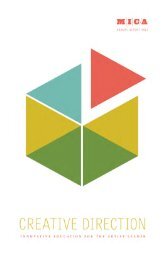art/vision/voice - Maryland Institute College of Art
art/vision/voice - Maryland Institute College of Art
art/vision/voice - Maryland Institute College of Art
Create successful ePaper yourself
Turn your PDF publications into a flip-book with our unique Google optimized e-Paper software.
conclusion: la resolana 99<br />
visual and performing <strong>art</strong>s disciplines. P<strong>art</strong>nership activities have taken<br />
place both in the community and at campus sites, and the cap institutions<br />
have seen that maintaining that flexibility—to meet the community<br />
in their space while still providing opportunities to come to a college<br />
campus—has been essential to the dynamic nature <strong>of</strong> these p<strong>art</strong>nerships.<br />
The private colleges <strong>of</strong> <strong>art</strong>—Cooper Union, Columbia, and mica—have<br />
long histories <strong>of</strong> <strong>art</strong>s-based community programming, <strong>of</strong> commitment<br />
to public and civic engagement, and <strong>of</strong> responding to urban needs.<br />
However, their core focus is on providing outstanding educations for<br />
high-performing students in <strong>art</strong>s and design. Some <strong>of</strong> their communitybased<br />
work has taken place in continuing education and outreach programs<br />
beyond the curriculum’s fine <strong>art</strong>s model; some through curriculum-based<br />
programs in <strong>art</strong> education or design. On the other hand, both<br />
csumb—a p<strong>art</strong> <strong>of</strong> one <strong>of</strong> the nation’s largest public systems <strong>of</strong> higher<br />
education—and Xavier—a private university founded by religious leaders<br />
to address the educational needs <strong>of</strong> a p<strong>art</strong>icular population in<br />
New Orleans—have at the core <strong>of</strong> their missions a mandate to address<br />
under-served educational needs in their regions. The challenges in<br />
delivering a community-based p<strong>art</strong>nership program within an institution<br />
with a fine <strong>art</strong>s model differ from those that arise within institutions<br />
whose original mandate is to educate the under-served.<br />
In developing our p<strong>art</strong>nerships, the cap institutions have worked<br />
to move institutions from an outreach or missionary model to one <strong>of</strong><br />
reciprocity and respect for community history and knowledge. The ability<br />
to know the p<strong>art</strong>ner’s community identity and cultural dispositions is<br />
integral to the success <strong>of</strong> these collaborations. Equally important is the<br />
ability to identify the culture <strong>of</strong> the institution. The fine <strong>art</strong>s institutions<br />
have undertaken the critical step <strong>of</strong> introducing community-based and<br />
service-learning courses and curricula. The institutions with social<br />
justice goals and curricula have had to undertake p<strong>art</strong>nerships in ways<br />
that integrate diverse aesthetics into the curriculum.<br />
Many <strong>of</strong> our community p<strong>art</strong>ners are connected to multicultural<br />
neighborhoods where p<strong>art</strong>icular ethnic and racial groups have had long<br />
histories. The p<strong>art</strong>nerships have sought to relate to and respect this rich<br />
diversity, and community cultures have played an important role in the<br />
relevancy <strong>of</strong> the projects, as well as in the challenges that have arisen.<br />
The economic resources in the communities served by the p<strong>art</strong>nerships<br />
<strong>of</strong>ten stand in stark contrast to those <strong>of</strong> the larger institution, and<br />
acknowledging this inequality is p<strong>art</strong> <strong>of</strong> the negotiation required to<br />
provide needed services and to share resources. Perhaps a more intimate<br />
negotiation is the need for college students and faculty to understand the<br />
reality <strong>of</strong> the context in which they find themselves. The history <strong>of</strong><br />
neglect that many community youth and their families have faced in the
















